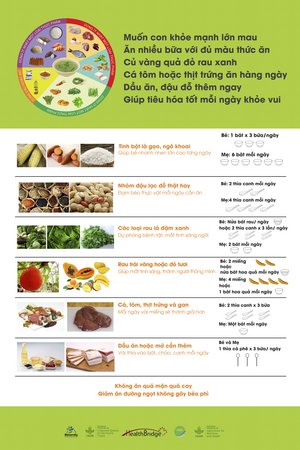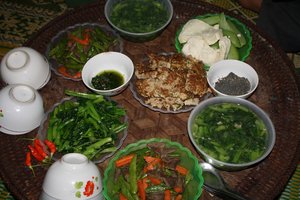Joining the diversity club – how village health workers in Vietnam are putting nutrition back on the menu

In the fifth of her blog reports from Vietnam, Jessica Raneri, Nutrition Programme Specialist, explains how Diversity Clubs in the Mai Son district in Son La Province are getting equipped to lead the next step of the research. The goal? To add nutritious agricultural biodiversity to the menu.
In the fifth of her blog reports from Vietnam, Jessica Raneri , Nutrition Programme Specialist, explains how Diversity Clubs in the Mai Son district in Son La Province are getting equipped to lead the next step of the research. The goal? To add nutritious agricultural biodiversity to the menu.
In my last blog, I explained how we had analyzed the data gathered from the household surveys, and how that analysis had informed the next step – when we worked closely with the communities and local health and agricultural partners to design appropriate interventions to improve nutrition in the project sites. Now it is time to put those plans into action with the help of the village health workers who will lead ‘Diversity Clubs’.
The first step was to train not only the village health workers who would become the Diversity Club Leaders, but also the commune and district health workers who will provide additional support and ensure that the knowledge gained during the project will be incorporated into ‘standard’ nutrition and health checks carried out at the commune health centre.

The training of the village health worker’s consisted of two linked parts, one on agriculture capacity development and the second on nutrition. Both included aspects of capacity building on how to facilitate a village community group, how to mobilize and inform participants about the research, and how to monitor progress. These sessions were connected by focusing on messaging around three key food groups – dark green leafy vegetables, vitamin-A rich fruit and vegetables, and legumes, and even more specifically, towards the keyset of foods from these groups selected by communities during the Participatory Identification of Intervention Approach (PIIA) – see blog here. Building this connection will ensure that the nutrition and agriculture components are directly linked.
On the first day of nutrition training, we developed new and adapted recipes with the village health workers that included the foods identified from the food focus groups. This was followed by asking if they were willing to contribute food and cooking utensils towards the training for the cooking demonstrations, development of recipes that will eventually be included in the diversity club session plans. The response was positively overwhelming. While we had budgeted to have to purchase foods, each and every person was willing to contribute something and in the end, we only needed to supply the cooking stoves and fuel. This was great, because we believe in leading by example. We hoped that the village health workers would also ask the diversity club participants to contribute to their cooking demonstrations, and to make the experience richer by using more diverse foods than those supplied by the club, and this proved to be the case. It also provided an opportunity for the communities to literally ‘buy-in’ to, and develop ownership of, their clubs.
 One of the food groups that they were asked to bring were dark green leafy vegetables. We were pleasantly surprised to see that we ended up with seven different varieties. We discussed if everyone grew all seven, and as expected the answer was no – from our baseline surveys we know households only produce (and subsequently consume) two or three different varieties yet at the landscape level, there are many more being produced. It was again a good opportunity to promote the importance of diversifying what they grow and eat. In response to ‘we don’t have space to grow more’, we encouraged smaller plots of more types, trying to expand the garden, and swapping food/crops with their neighbours. Village health workers are taught how to use the nutrition education materials; a leaflet and calendar with the key messages that the intervention will communicate. Perhaps their favourite aspect of these is a poem that was put together by the research team in the attempt to make recalling these messages easier and more interactive.
One of the food groups that they were asked to bring were dark green leafy vegetables. We were pleasantly surprised to see that we ended up with seven different varieties. We discussed if everyone grew all seven, and as expected the answer was no – from our baseline surveys we know households only produce (and subsequently consume) two or three different varieties yet at the landscape level, there are many more being produced. It was again a good opportunity to promote the importance of diversifying what they grow and eat. In response to ‘we don’t have space to grow more’, we encouraged smaller plots of more types, trying to expand the garden, and swapping food/crops with their neighbours. Village health workers are taught how to use the nutrition education materials; a leaflet and calendar with the key messages that the intervention will communicate. Perhaps their favourite aspect of these is a poem that was put together by the research team in the attempt to make recalling these messages easier and more interactive.
 Preparing and cooking the foods together was really a fun experience. It seems wherever I am in the world, whenever people talk about food and cooking, people get engaged and excited. Eager to share their tips and tricks, family secrets passed down generation to generation. And Vietnam is no exception to the rule. As we prepare the different dishes, which will ultimately become our lunch, we discuss and debate how much of each ingredient we should put in the dishes, some use several large handfuls of beans in their soups, others use only small amounts. Often, it’s just what they are used to doing. But we are able to come to a compromise between all the different opinions, by focusing on the fact that the foods from the three key foods groups should be the ‘stars’ of the dishes.
Preparing and cooking the foods together was really a fun experience. It seems wherever I am in the world, whenever people talk about food and cooking, people get engaged and excited. Eager to share their tips and tricks, family secrets passed down generation to generation. And Vietnam is no exception to the rule. As we prepare the different dishes, which will ultimately become our lunch, we discuss and debate how much of each ingredient we should put in the dishes, some use several large handfuls of beans in their soups, others use only small amounts. Often, it’s just what they are used to doing. But we are able to come to a compromise between all the different opinions, by focusing on the fact that the foods from the three key foods groups should be the ‘stars’ of the dishes.
Lunch is cooked, served and eaten with vigour. We discuss if they are happy with the new and adapted recipes, some suggest adding more of a specific ingredient and others cooking something for a longer or shorter time. We make a few edits to the recipe, happy with the final product and start planning for when the VHW will facilitate their first diversity club meeting.
Jessica Raneri
Download:
Read Jessica’s other blogs about this research:
Part 1 : Assessing the nutrition potential of diverse local foods in Vietnam
Part 2 : Bringing together best methods to assess food quality and dietary intake in Vietnam
Part 3 : Improving dietary quality and diversity through systems innovation
Part 4 : Putting nutrition data to work in the community
Part 6: Spicing it up to increase vitamin A consumption in Vietnam
Additional information:
This is part of research under the CGIAR Research Programs on Humidtropics and Agriculture for Nutrition and Health, and contributes to Bioversity International's Healthy Diets from Sustainable Food Systems Initiative. The focus of this research is on women of child-bearing age and children between 12-23 months - an age group part of the critical 1000 day window for child development and the stage where they are able to consume a more diverse diet. As such, it is from this age group that biodiversity can have an effect on the diet.
Photo captions:
Training of diversity club leaders - practicing cooking demonstration and revised recipes.
Meal prepared by and consumed by diversity club - developing diverse meals promoting food groups lacking in the diet.
Pumpkin and beans - combining food groups lacking in the diet.
Credit: Bioversity International/K. Hoang
